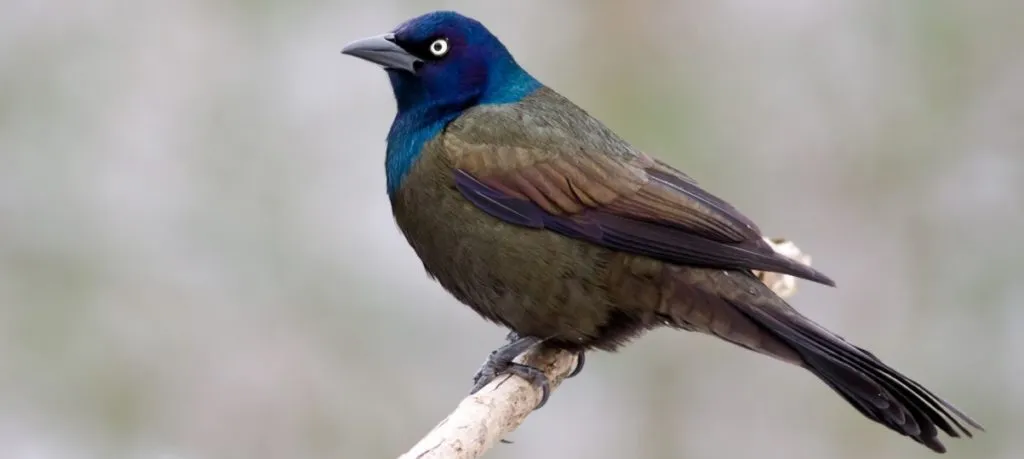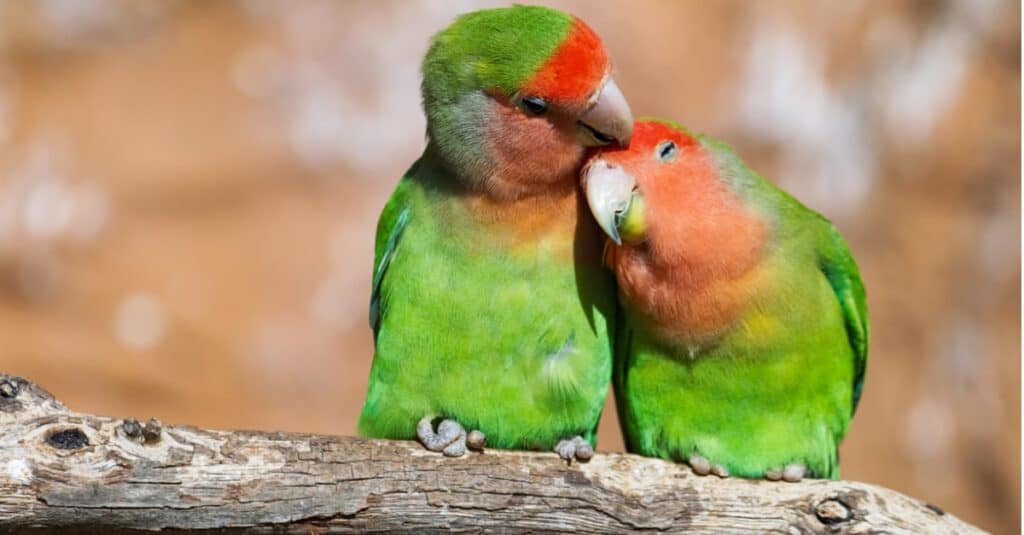Yellow Birds In Michigan Discovering Yellow Birds in Michigan: A Guide with Stunning Photos Bird Watching in Michigan: A Comprehensive Guide to Yellow Birds Identifying Yellow Birds Found in Michigan: A Visual Guide The Yellow Birds of Michigan: An Illustrated Guide to Species From Goldfinches to Warblers: A Look at Yellow Birds in Michigan.

Yellow Birds In Michigan
25 BIrds Yellow Birds In Michigan
- American Goldfinch
- Cedar Waxwing
- Common Yellowthroat
- Yellow Warbler
- Baltimore Oriole Female
- Yellow-Rumped Warbler
- American Redstart Female
- Nashville Warbler
- Black-throated Green Warbler
- Scarlet Tanager
- Eastern Meadowlark
- Magnolia Warbler
- Pine Warbler
- Yellow-throated Vireo
- Blue-winged Warbler
- Cape May Warbler
- Wilson’s Warbler
- Orchard Oriole
- Evening Grosbeak
- Canada Warbler
- Orange-crowned Warbler
- Hooded Warbler
- Dickcissel
- Prothonotary Warbler
- Yellow-headed Blackbird
American Goldfinch
- Spinus tristis
- Length: 4.3-5.1 in (11-13 cm)
- Weight: 0.4-0.7 oz (11-20 g)
- Wingspan: 7.5-8.7 in (19-22 cm)

American Goldfinch
The American Goldfinch, scientifically known as Spinus tristis, is a small yet striking bird species native to North America. Its size ranges from 4.3-5.1 inches (11-13 cm) and a weight of 0.4-0.7 ounces (11-20 g), making it a lightweight and agile member of the avian world. Their wingspans vary between 7.5-8.7 inches (19-22 cm), further contributing to their efficient, graceful flight patterns. These charming birds can be identified by their vivid yellow plumage, accented with black markings on their wings and head, showcasing an eye-catching contrast that makes them visually appealing. As frequent guests at bird feeders, American Goldfinches are known for their sweet, melodic songs and social nature, often congregating in small flocks. Their lively presence and enchanting tunes make them a beloved component of North American fauna and a sight for bird enthusiasts and casual observers alike.
Cedar Waxwing
The Cedar Waxwing is a captivating bird species known for its distinctive and elegant appearance. With a length ranging between 6 to 7 inches, this medium-sized bird boasts a sleek, crested head and striking black eye mask. The Cedar Waxwing’s weight typically falls between 1 to 1.2 ounces, making it a lightweight yet powerful flier. In addition, with a wingspan of roughly 9 to 12 inches, the bird is proficient at maneuvering through dense foliage and trees. An impressive aspect of the Cedar Waxwing is its lifespan, as it can live for an average of 8 years in the wild. Overall, the Cedar Waxwing is a remarkable bird that captivates birdwatchers and nature enthusiasts with its unique characteristics and stunning appearance.
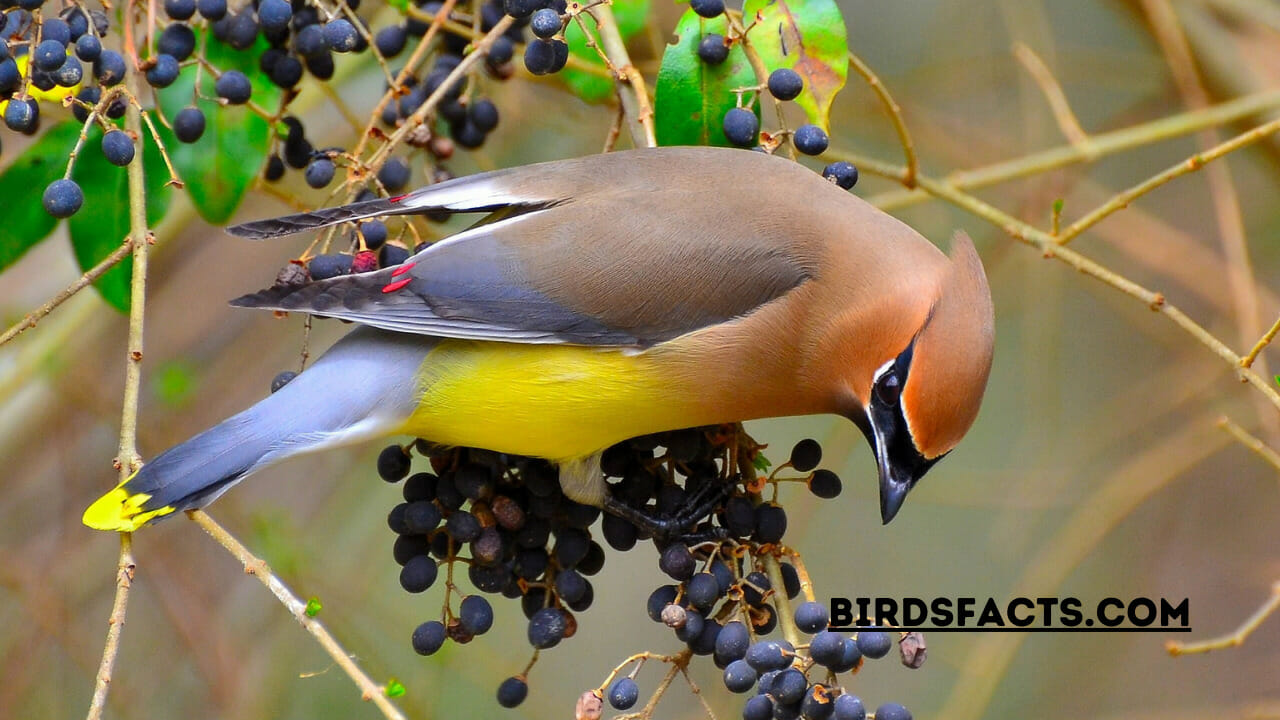
Cedar Waxwing
Cedar Waxwing Facts
- Prey
- berries, small fruit, flowers, oozing sap, and insects.
- Name Of Young
- Chicks
- Group Behavior
- Social
- Fun Fact
- Their feathers have red, waxy tips that can be hard to identify unless you’re up close.
- Estimated Population Size
- 64 million
- Biggest Threat
- Collisions with cars and windows
- Most Distinctive Feature
- Rotund bodies and flat crests
- Distinctive Feature
- Large heads, short bills
- Wingspan
- 8.7 to 11.8 inches
- Incubation Period
- 12 to 13 days
- Age Of Fledgling
- 14 to 18 days
- Habitat
- Open woodlands with fruiting trees
- Predators
- merlins, hawks, grackles, and bullfrogs.
- Diet
- Omnivore
- Lifestyle
- Diurnal
- Favorite Food
- Berries
- Type
- Bird
- Common Name
- Cedar waxwing
- Location
- North America
- Nesting Location
- Trees on a horizontal branch
- Migratory
- 1
- Color
- Brown
- Grey
- Yellow
- Red
- Black
- White
- Skin Type
- Feathers
- Top Speed
- 25 mph
- Lifespan
- 8 years
- Weight
- 1.1 ounces
- Length
- 6 to 7 inches
- Age of Sexual Maturity
- One year
Common Yellowthroat
The Common Yellowthroat is a small and charmingly attractive songbird across North America. With a length of approximately 4.3 to 5.1 inches and a weight of around 0.3 to 0.4 ounces, this tiny creature is easily identified by its bright yellow throat and distinctive black “bandit” mask across its face. Its wingspan ranges between 5.9 to 7.5 inches, giving it agility and grace as it flits through the sky. As members of the New World warbler family, Common Yellowthroats are often observed in marshes, wetlands, and other shrubby habitats, where they feed on insects and spiders, contributing to the natural balance of their ecosystems. The striking contrasts in their coloration and charming behavior make the Common Yellowthroat a delightful sight for birdwatchers and nature enthusiasts alike. Despite their small size, these birds possess a remarkable presence and durability, allowing them to thrive in various environments throughout North America and showcasing the incredible beauty and adaptability inherent in the animal kingdom.
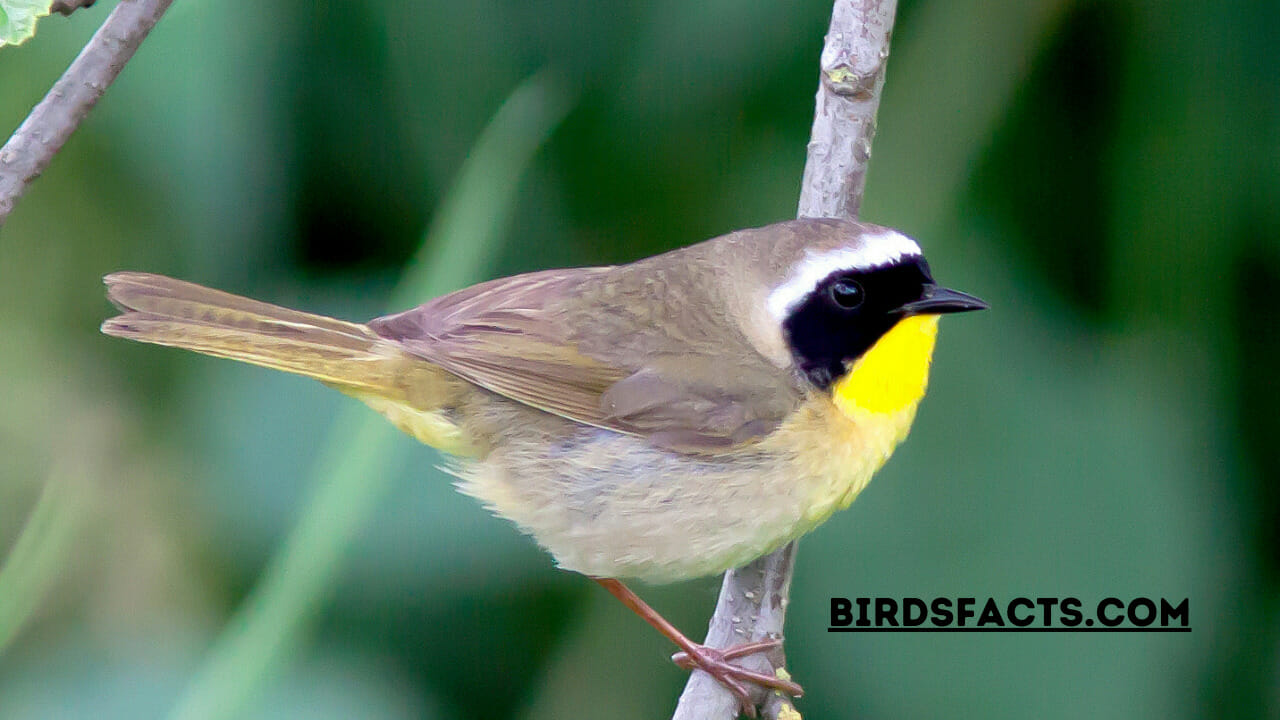
Common Yellowthroat
Common Yellowthroat Facts
- Prey
- Insects, spiders, larvae, invertebrates
- Main Prey
- Insects
- Name Of Young
- Chicks
- Group Behavior
- Solitary/Pairs
- Flocks
- Fun Fact
- The Common Yellowthroat stays close to the ground and uses stealth to survive!
- Estimated Population Size
- 77 million mature individuals
- Biggest Threat
- Habitat degradation
- Most Distinctive Feature
- Black mask rimmed in white above
- Distinctive Feature
- Bright yellow bib and underparts; olive-brown upper parts; sharp, pointed black bill; black eyes; pinkish legs and feet; females lack mask
- Other Name(s)
- Maryland Yellowthroat, Mascarita común (Spanish), Pauline masque (French)
- Wingspan
- 5.9 – 7.5 inches
- Incubation Period
- 12 days
- Age Of Fledgling
- 10 – 12 days
- Habitat
- Marshes, wetlands, open pine forests, grasslands, prairies, shrublands, and other areas with dense, low vegetation
- Predators
- Hawks, falcons, Loggerhead Shrikes, raccoons, mice, chipmunks, snakes, skunks, opossums
- Diet
- Insectivore
- Lifestyle
- Diurnal
- Solitary
- Flock
- Pair
- Favorite Food
- Insects
- Common Name
- Common Yellowthroat
- Special Features
- Black mask with white rim above; bright yellow underparts
- Number Of Species
- 1
- Location
- North America, Central America, and the Caribbean
- Average Clutch Size
- 4
- Nesting Location
- On the ground or near the ground in dense vegetation
- Migratory
- 1
- Color
- Brown
- Yellow
- Black
- White
- Olive
- Skin Type
- Feathers
- Lifespan
- 10 years
- Weight
- 0.3 ounces
- Length
- 4.3 – 5.1 inches
- Age of Sexual Maturity
- 1 year
- Venomous
- No
- Aggression
- Medium
Yellow Warbler
The Yellow Warbler, scientifically known as Setophaga petechia, is a striking small bird with vibrant yellow plumage, which makes it easily distinguishable from other warbler species. Its length typically ranges between 4.7 to 5.1 inches, weighing about 0.32 to 0.35 ounces. With its impressive wingspan stretching from 6.3 to 7.9 inches, the Yellow Warbler showcases its quick, agile flight mastery. This species of Warbler is native to the Americas and can be found in various habitats, such as wooded areas, gardens, and wetlands, where they predominantly feed on insects. Aside from their unique coloring, Yellow Warblers possess a distinct melodious song that is easily recognizable amongst bird enthusiasts and nature lovers. These perky birds are also known for their incredible nesting instincts, where they are found skillfully weaving intricate nests from plant materials and spider webs. The Yellow Warbler contributes to the ecosystem’s balance and adds a touch of brilliance and whimsy to our environment with its delightful presence and enchanting tunes.

Yellow Warbler
Warbler Facts
- Prey
- Insects, spiders, caterpillars, mosquito larvae
- Main Prey
- Insects
- Group Behavior
- Solitary
- Solitary/Group
- Solitary/Pairs
- Small families
- Fun Fact
- Warblers are so-called because of the trills of their song.
- Biggest Threat
- brood parasitism, humans, winters
- Incubation Period
- 12 days
- Age Of Independence
- 2-3 weeks
- Age Of Fledgling
- 10 days
- Diet
- Omnivore
- Lifestyle
- Group
- Pair
- Favorite Food
- Insects, spiders
- Common Name
- warbler
- Average Clutch Size
- 2
- Nesting Location
- Arboreal, bushes, trees, forest floor
- Migratory
- 1
- Color
- Brown
- Grey
- Yellow
- Red
- Gold
- Green
- Lifespan
- 4-12 years
- Weight
- 0.1-2 oz
- Length
- 3-10 inches
- Age of Weaning
- 2-3 weeks
- Venomous
- No
Baltimore Oriole Female
- Icterus galbula
- Length: 6.7-7.5 in (17-19 cm)
- Weight: 1.1-1.4 oz (30-40 g)
- Wingspan: 9.1-11.8 in (23-30 cm)

Baltimore Oriole Female
The Baltimore Oriole, a vibrant bird belonging to the species Icterus galbula, boasts an impressive display of bright and colorful plumage. While the males showcase striking orange and black feathers, the female Baltimore Oriole exhibits a more subtle color palette with yellowish-orange and dark gray or brown hues. These females are slightly smaller in size, measuring a length of 6.7-7.5 inches (17-19 cm), a wingspan ranging from 9.1-11.8 inches (23-30 cm), and weighing between 1.1-1.4 ounces (30-40 g). Despite their less conspicuous appearance than the males, these female birds play an equally crucial role in the species’ survival and reproduction. They exhibit excellent nesting skills, weaving intricate structures to protect their future offspring. Female Baltimore Orioles embodies the perfect balance of beauty, grace, and resilience that has made them a bird-watching favorite throughout their native habitats in North America.
Yellow-Rumped Warbler
- Setophaga coronata
- Length: 4.7-5.5 in (12-14 cm)
- Weight: 0.4-0.5 oz (12-13 g)
- Wingspan: 7.5-9.1 in (19-23 cm)

Yellow-Rumped Warbler
The Yellow-Rumped Warbler, scientifically known as Setophaga coronata, is a small yet striking bird species characterized by its unique features and dimensions. Measuring a length of 4.7-5.5 inches (12-14 cm) and boasting a wingspan ranging from 7.5-9.1 inches (19-23 cm), this little creature is easily recognized by bird enthusiasts worldwide. With a weight of just 0.4-0.5 ounces (12-13 grams), the Yellow-Rumped Warbler is a lightweight, handy flyer, allowing it to navigate various environments gracefully. The bird’s breathtaking colors further add to its charm; it proudly displays its vivid and varying shades of yellow, particularly on its rump, earning it its distinctive name. In addition to its remarkable physical traits, the Yellow-Rumped Warbler is known for its impressive lifespan, which stands as a testament to the resilience and tenacity of this tiny avian wonder. The Setophaga coronata, or Yellow-Rumped Warbler, is a fascinating bird that perfectly showcases nature’s unparalleled beauty and diversity.
American Redstart Female
- Setophaga ruticilla
- Length: 4.3-5.1 in (11-13 cm)
- Weight: 0.2-0.3 oz (6-9 g)
- Wingspan: 6.3-7.5 in (16-19 cm)

american redstart spiritual meaning
The American Redstart Female, scientifically known as Setophaga ruticilla, is a remarkably stunning and agile songbird that belongs to the Parulidae family. With a size ranging from 4.3 to 5.1 inches in length (11-13 cm) and a weight of just 0.2-0.3 ounces (6-9 g), these captivating creatures are quite small and lightweight, making them adept at navigating through their preferred woodland habitats. Their wingspan, which measures between 6.3 and 7.5 inches (16-19 cm), enables them to dart swiftly from branch to branch as they forage for insects on tree foliage. Female American Redstarts exhibit an elegant blend of muted colors, typically sporting gray or olive-green plumage on their upper body, with pale yellow accents on the sides of their chest and under their wings. Their beauty is captivating, and they play an important role in controlling insect populations within their ecosystems. As migratory birds, these charming feathered creatures grace the landscapes of North and Central America, often breeding in the northern regions and wintering in more tropical areas, amusing birdwatchers and enthusiasts alike with their enchanting presence and positive behaviors.
Nashville Warbler
- Leiothlypis ruficapilla
- Length: 4.3-5.1 in (11-13 cm)
- Weight: 0.2-0.5 oz (6.7-13.9 g)
- Wingspan: 6.7-7.9 in (17-20 cm)

Nashville Warbler
The Nashville Warbler, scientifically known as Leiothlypis ruficapilla, is a small yet fascinating bird species with impressive characteristics. With a length ranging from 4.3 to 5.1 inches (11-13 cm), these birds may seem petite, but their striking appearance makes up for their size. The weight of a Nashville Warbler typically varies between 0.2 to 0.5 ounces (6.7-13.9 g), making them incredibly light and agile creatures. Their wingspan measures 6.7 to 7.9 inches (17-20 cm), which is great considering their small body mass. Their slender shape and distinctive color patterns set them apart from other similar bird species. The Nashville Warbler embodies the perfect blend of beauty and grace, making it captivating for birdwatchers and nature enthusiasts alike.
Black-Throated Green Warbler
- Setophaga virens
- Length: 4.3-4.7 in (11-12 cm)
- Weight: 0.3-0.4 oz (7-11 g)
- Wingspan: 6.7-7.9 in (17-20 cm)
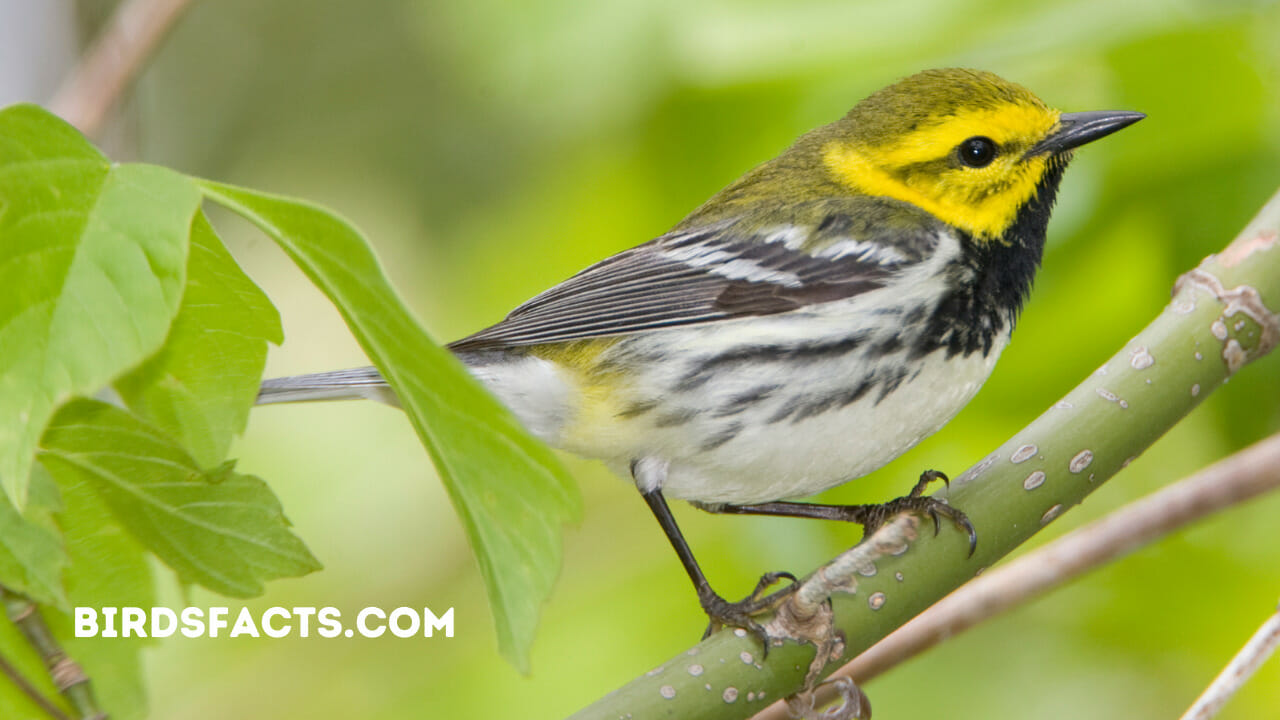
Black-Throated Green Warbler
The Black-throated Green Warbler (Setophaga virens) is a striking small bird characterized by its lively colors and melodious song. With a length of 4.3-4.7 inches (11-12 cm) and a weight of 0.3-0.4 ounces (7-11 g), this tiny songbird is visually captivating with its distinctive black throat, vibrant yellow face, and olive-green back. Not only is the size of this bird species impressive, but so is its wingspan, which ranges from 6.7-7.9 inches (17-20 cm). As a member of the Setophaga genus, the Black-throated Green Warbler is part of a group of brilliantly colored avian species that are widespread and iconic across the woodlands of North America. It is primarily an insectivore, feeding mostly on caterpillars and other small insects, which further establishes its important role in the ecosystem, controlling pest populations. As delicate and fascinating as the Black-throated Green Warbler is, it continues to dazzle birdwatchers and casual admirers alike.
Palm Warbler
- Setophaga palmarum
- Length: 4.7-5.5 in (12-14 cm)
- Weight: 0.3-0.5 oz (7-13 g)
- Wingspan: 7.9-8.3 in (20-21 cm)
The Palm Warbler, also known as Setophaga palmarum, is a small and distinctive bird found in various habitats across North America. Measuring only 4.7-5.5 inches (12-14 cm) in length and weighing a mere 0.3-0.5 ounces (7-13 g), the Palm Warbler is a tiny yet significant member of the avian community. Boasting a wingspan between 7.9-8.3 inches (20-21 cm), this agile bird can easily flit between treetops, foraging insects, and other food sources. The Palm Warbler exhibits unique coloring and markings, with a mix of brownish-gray and olive on its back, while its breast and belly display a striking yellow hue.
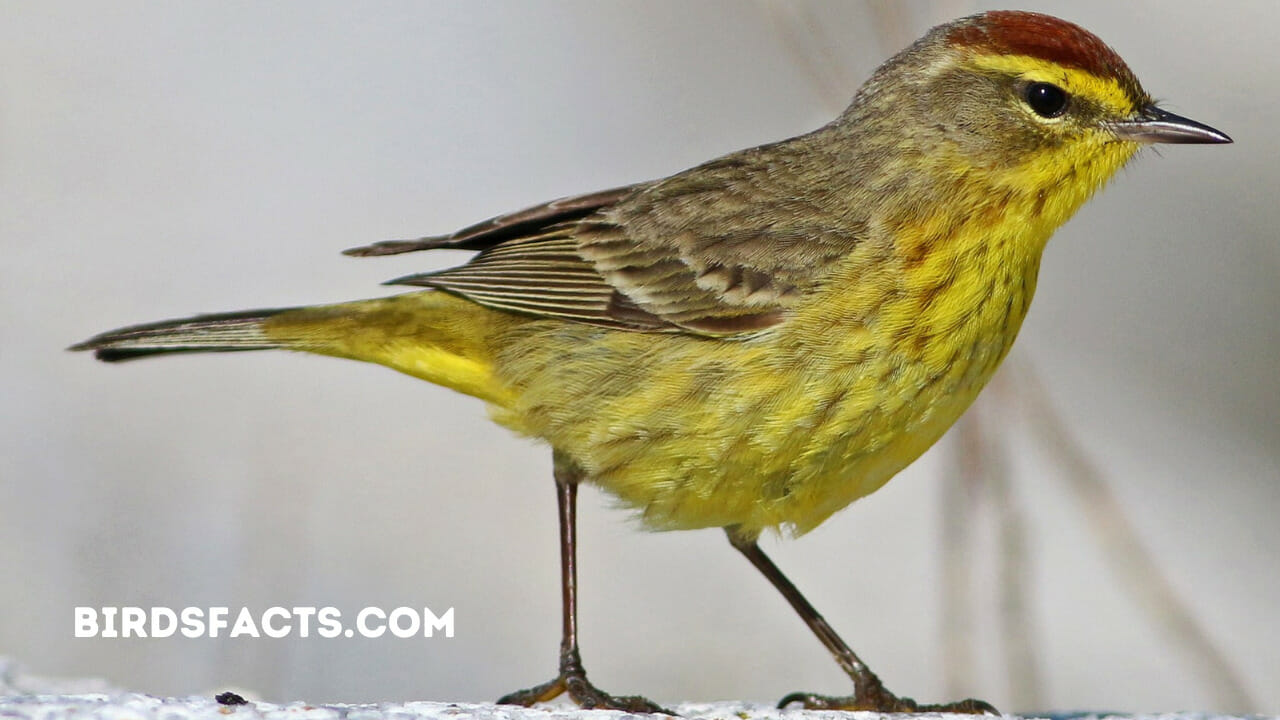
Palm Warbler
These vibrant birds are often seen during the colder months as they migrate to warmer climates to escape the frigid temperatures of their breeding grounds. The Palm Warbler can be found in diverse habitats such as grasslands, wetlands, forests, and even urban gardens, making it a widespread and versatile species. As it constantly wags its tail and bobs its head, it delights birdwatchers and passersby alike. Despite its small size and delicate appearance, the Palm Warbler is a resilient and adaptive bird that can thrive in various environments. Its presence in varied habitats is a testament to its tenacity and adaptability, showcasing the impressive capabilities of nature’s creatures amid ongoing environmental changes.
Scarlet Tanager
The Scarlet Tanager, or Piranga olivacea, is a strikingly beautiful songbird known for its vivid colors and melodic song. With a length of 6.3 to 6.7 inches (16 to 17 cm) and a weight ranging between 0.8 to 1.3 ounces (23 to 38 grams), this small avian creature has a compact yet elegant body that easily captures attention. This lively bird also boasts an impressive wingspan of 9.8 to 11.4 inches (25 to 29 cm), allowing it to soar through the skies gracefully. The male Scarlet Tanager is distinguished by its bright red feathers and contrasting bold black wings, whereas the female sports a more muted yellow-green plumage. These magnificent birds can be found inhabiting the forests of North America during the warmer months, where they are easily identifiable as they flit from tree to tree. The Scarlet Tanager’s vibrant appearance and enchanting vocals will surely delight birdwatchers and nature enthusiasts, making this species a true gem of the avian world.

Scarlet Tanager
Scarlet Tanager Facts
- Prey
- They eat mainly invertebrates, including moths, butterflies, ants, and beetles
- Main Prey
- Invertebrates
- Name Of Young
- Chicks
- Group Behavior
- Solitary/Pairs
- Flocks
- Fun Fact
- Males molt into an olive-yellow color during the fall and winter
- Estimated Population Size
- 2.6 million
- Biggest Threat
- Habitat loss and climate change
- Most Distinctive Feature
- Black and red contrasting colors
- Distinctive Feature
- Thick bills and short, broad tails
- Wingspan
- 9.8 to 11.4 inches
- Incubation Period
- 12 to 14 days
- Age Of Independence
- 3 to 4 weeks
- Age Of Fledgling
- 15 days
- Habitat
- Mature forests
- Diet for this Fish
- Insectivore
- Lifestyle
- Diurnal
- Favorite Food
- moths and butterflies
- Type
- Bird
- Common Name
- Scarlet tanager
- Location
- North America and South America
- Nesting Location
- Shady deciduous trees
- Age of Molting
- One year
- Migratory
- 1
- Color
- Red
- Black
- White
- Olive
- Skin Type
- Feathers
- Lifespan
- up to 11 years
- Weight
- 0.8 to 1.3 ounces
- Length
- 6.3 to 6.7 inches
- Age of Sexual Maturity
- one year
Eastern Meadowlark
The Eastern Meadowlark, scientifically known as Sturnella magna, is a remarkable bird species native to eastern North America. Characterized by its striking features, this beautiful creature measures 7.5 to 10.2 inches (19-26 cm) in length and has a wingspan that spans from 13.8 to 15.8 inches (35-40 cm), enabling it to soar through the skies effortlessly. In terms of weight, these birds can range anywhere from 3.2 to 5.3 ounces (90-150 g), depending on their size and structure. Donning a distinct and eye-catching plumage, the Eastern Meadowlark is a sight to behold within its natural habitat. Boasting a harmonious blend of vibrant colors and intricate patterns, this bird is truly a testament to the marvels of nature. Additionally, its impressive wingspan and light weight allow it to navigate its surroundings easily and gracefully, effortlessly capturing bird enthusiasts’ attention and admiration. As a key component of its native ecosystem, the Eastern Meadowlark, Sturnella magna, is an exquisite specimen demonstrating the incredible diversity and beauty present in the world of avian life.

Eastern Meadowlark
Eastern Meadowlark Facts
- Prey
- Caterpillar, grasshopper, cutworm, and beetle.
- Fun Fact
- They can live up to 9 years.
- Estimated Population Size
- 37 million
- Biggest Threat
- Habitat loss
- Most Distinctive Feature
- Black V-shaped breastband
- Distinctive Feature
- Yellow belly
- Other Name(s)
- Sturnella Magna
- Wingspan
- 13.78 to 15.75 inches
- Incubation Period
- 13 to 14 days
- Age Of Independence
- 25 to 26 days
- Litter Size
- Three to seven eggs
- Habitat
- Prairies, meadows, fields, and grasslands.
- Predators
- Hawks, falcons, owls, skunks, foxes, and coyotes.
- Diet
- Omnivore
- Common Name
- Eastern Meadowlark
- Number Of Species
- 17
- Location
- The United States of America, Canada, México, Central America, and South America
- Average Clutch Size
- 5
- Nesting Location
- On the ground
- Migratory
- 1
- Skin Type
- Feathers
- Top Speed
- 24 mph
- Length
- Females range from 7.48 to 9.06 inches, while males range from 8.27 to 10.24 inches.
Magnolia Warbler
The Magnolia Warbler, scientifically known as Setophaga magnolia, is a captivating bird species characterized by its striking features. This small bird stands out in the avian world with a length ranging from 4.3 to 5.1 inches (11 to 13 centimeters). Its weight measures 0.2 to 0.5 ounces (6 to 15 grams), making it lightweight and agile. The wingspan of a Magnolia Warbler spans from 6.3 to 7.9 inches (16 to 20 centimeters), allowing it to maneuver through its natural habitat effortlessly. Its vivid color patterns and elegant appearance catch the eye of bird enthusiasts and casual observers alike. The Magnolia Warbler’s distinct size and weight contribute to its nimble flight, making it a remarkable subject of study for ornithologists and birdwatchers. Overall, the Setophaga magnolia represents a beautiful and enchanting species and an example of the diverse and intricate world of birds.

Magnolia Warbler
Magnolia Warbler Facts
- Prey
- They mainly eat insects, including moths, beetles, and caterpillars.
- Name Of Young
- Chicks
- Group Behavior
- Social
- Pair
- Fun Fact
- They line their nests with fungi strands
- Estimated Population Size
- 39 million
- Biggest Threat
- Rising sea levels and spring heat waves
- Most Distinctive Feature
- Unique coloration
- Wingspan
- 6.3 to 7.9 inches
- Incubation Period
- 11 to 13 days
- Age Of Independence
- 25 days
- Age Of Fledgling
- 8 to 10 days
- Habitat
- lush forests
- Diet
- Insectivore
- Lifestyle
- Diurnal
- Favorite Food
- Moths, beetles, and budworms
- Type
- Bird
- Common Name
- Magnolia warbler
- Location
- North America, South America
- Average Clutch Size
- 4
- Nesting Location
- Dense conifers near the trunk’s base
- Migratory
- 1
- Color
- Grey
- Yellow
- Black
- White
- Skin Type
- Feathers
- Lifespan
- Their average lifespan is 2 years, but they can live up to 6 years
- Weight
- 0.23 to 0.53 ounces
- Length
- 4.3 to 5.1 inches
- Age of Sexual Maturity
- One year
Pine Warbler
- Setophaga pinus
- Length: 5.1-5.5 in (13-14 cm)
- Weight: 0.3-0.5 oz (9-15 g)
- Wingspan: 7.5-9.1 in (19-23 cm)

Pine Warbler
The Pine Warbler, scientifically known as Setophaga pinus, is a small yet captivating bird species predominantly found in the coniferous forests of North America. These delicate creatures boast a length that ranges between 5.1-5.5 in (13-14 cm), and they possess a weight of about 0.3-0.5 oz (9-15 g), making them a lightweight member of the animal kingdom. With a wingspan varying from 7.5-9.1 in (19-23 cm), the Pine Warbler’s flight is characterized by grace and agility, often capturing the attention of bird enthusiasts and casual observers alike. Their enchanting vocalizations fill the forest air with melodic tunes, contributing to the overall atmosphere of their natural habitats. Given their size and unique characteristics, Pine Warblers are a fascinating subject of study and appreciation among ornithologists and nature lovers who seek to unravel the mysteries and learn more about the intricacies of these feathered wonders.
Yellow-throated Vireo
- Vireo flavifrons
- Length: 5.1-5.9 in (13-15 cm)
- Weight: 0.5-0.7 oz (15-21 g)
- Wingspan: 9.1 in (23 cm)
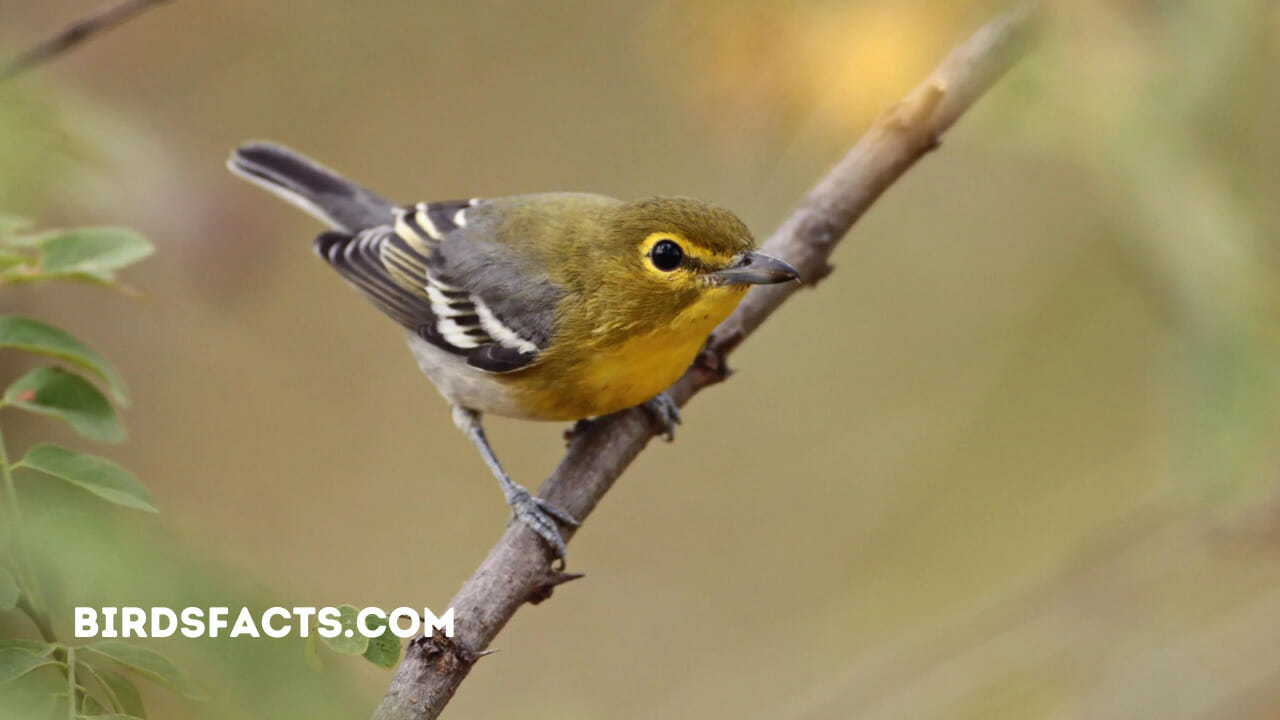
Yellow-throated Vireo
The Yellow-throated Vireo (Vireo flavifrons) is a small, vibrantly colored songbird with a characteristic bright yellow head, throat, and breast, which sets it apart from other vireos. Its dimensions include a length of 5.1-5.9 inches (13-15 cm), a weight of 0.5-0.7 ounces (15-21 grams), and a wingspan of 9.1 inches (23 cm), making it a relatively medium-sized bird within its family. This species is primarily arboreal, inhabiting wooded areas and utilizing trees for nesting and resting purposes. Due to their size and coloring, they can blend into their surroundings quite well, making it difficult to spot them. They are most active during the day and have a melodic, complex, and distinctive song that plays an important role in attracting mates and defending their territories. Yellow-throated Vireos are insectivorous, primarily feeding on caterpillars, beetles, and other arthropods high up in the trees. They are also known to consume small fruits and berries occasionally. These fascinating birds offer a glimpse into the complexity and beauty of avian life, drawing bird watchers worldwide for a chance to observe these elusive creatures.
Blue-winged Warbler
- Vermivora cyanoptera
- Length: 4.75 inches (12 cm)
- Weight: 0.3 oz (9 g)
- Wingspan: 6.75 – 7.5 inches (17 – 19 cm)
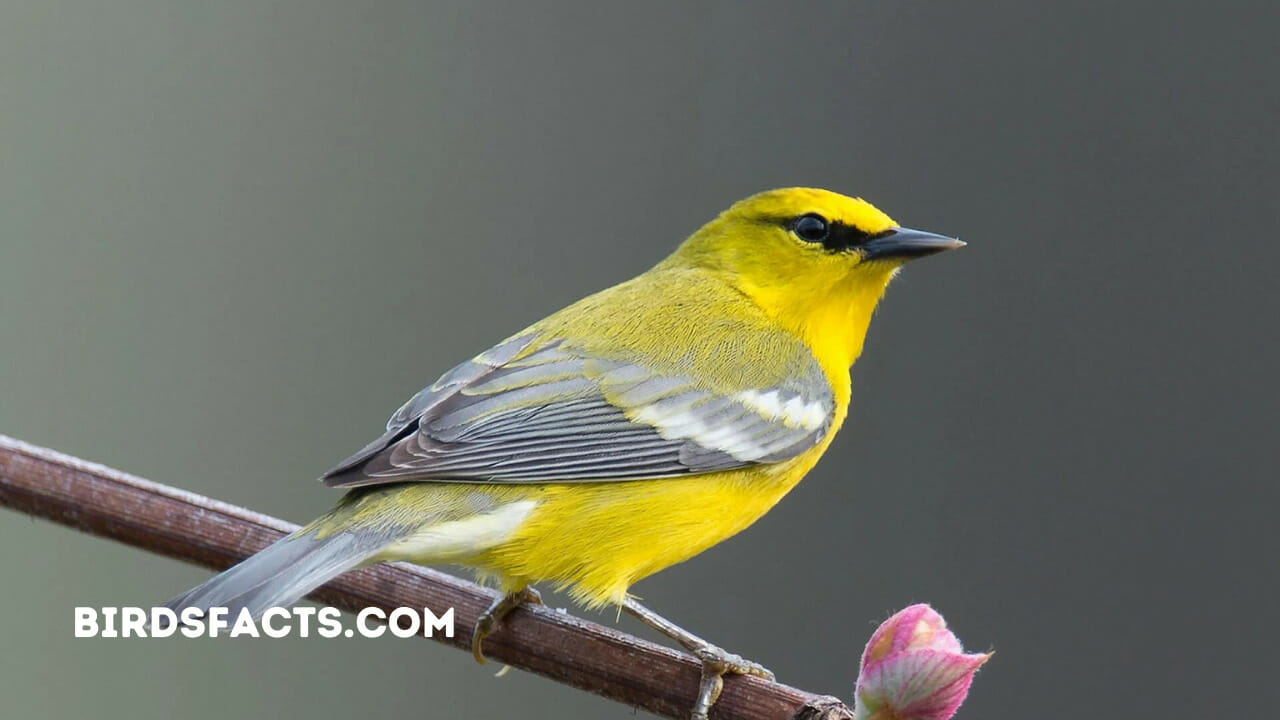
Blue-winged Warbler
The Blue-winged Warbler, scientifically known as Vermivora cyanoptera, is a small yet fascinating bird species that captures the attention of birdwatchers and nature enthusiasts alike. With a length of about 4.75 inches (12 cm) and a weight of approximately 0.3 oz (9 g), these birds are remarkable for their small size and delicate features. Their wingspan, ranging from 6.75 to 7.5 inches (17 – 19 cm), makes them adept at navigating the dense foliage of their preferred habitats, typically shrubby areas, thickets, and young forests. The Blue-winged Warbler is named after the striking blue feathers on its wings, which set it apart from other singers. As members of the Vermivora genus, these birds showcase their unique plumage by displaying a blend of blue and yellow color and hints of green throughout their bodies. Their vibrant colors make them easily recognizable to bird enthusiasts and provide an opportunity to admire their beauty in their natural environment. Overall, the Blue-winged Warbler showcases an incredible balance of form and function, combining its stunning appearance and ability to thrive in its preferred habitats.
Cape May Warbler
- Setophaga tigrina
- Length: 4.7-5.1 in (12-13 cm)
- Weight: 0.4-0.5 oz (10.2-15.2 g)
- Wingspan: 7.9-8.7 in (20-22 cm)

Cape May Warbler
The Cape May Warbler, scientifically known as Setophaga tigrina, is a small yet fascinating bird species native to North America. This delightful Warbler is compact yet agile in flight, measuring approximately 4.7 to 5.1 inches (12 to 13 cm) and with a wingspan ranging from 7.9 to 8.7 inches (20 to 22 cm). Despite its relatively modest weight of 0.4 to 0.5 ounces (10.2 to 15.2 grams), the Cape May Warbler is known for its striking and colorful plumage, which not only acts as an effective form of camouflage but also helps to attract mates during the breeding season. As part of the Setophaga genus, the Cape May Warbler shares certain physical and behavioral traits with other similarly-sized songbirds, such as its slender build and vocalizations. Whether you’re an avid birdwatcher or simply someone who appreciates the beauty of the natural world, the Cape May Warbler is undoubtedly a sight to behold.
Wilson’s Warbler
- Cardellina pusilla
- Length: 3.9-4.7 in (10-12 cm)
- Weight: 0.2-0.3 oz (5-10 g)
- Wingspan: 5.5-6.7 in (14-17 cm)
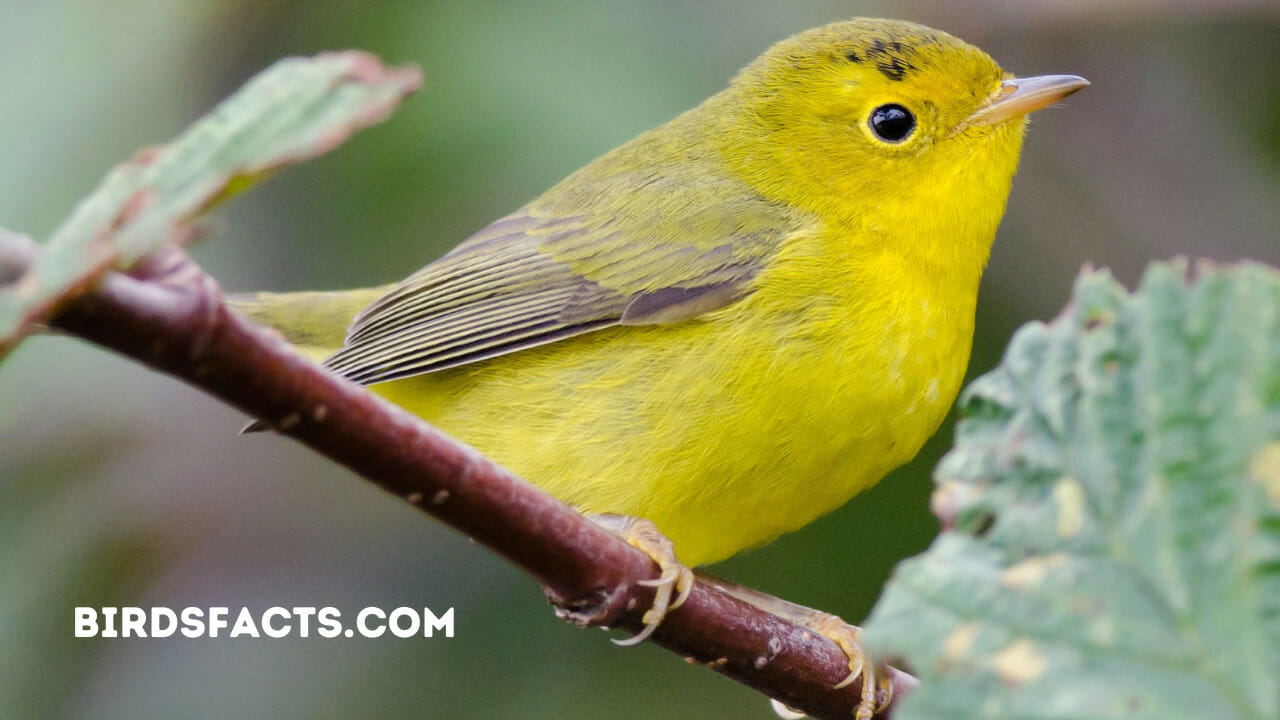
Wilson’s Warbler
Wilson’s Warbler, scientifically known as Cardellina pusilla, is a small, fascinating songbird with vibrant coloration and an energetic demeanor. With a body length ranging from 3.9 to 4.7 inches (10 to 12 centimeters) and a slight weight of just 0.2 to 0.3 ounces (5 to 10 grams), these lively birds can navigate their surroundings with agility and grace. Their wingspan, which measures between 5.5 and 6.7 inches (14 to 17 centimeters), further enhances their ability to glide through various habitats easily. Donned with a bright yellow body and striking black cap, the Wilson’s Warbler is easily recognizable by birders and nature lovers. The bird’s small size, combined with its distinctive appearance, adds to its visual appeal. Wilson’s Warblers contribute to the ecosystem by controlling pest populations as a creature that primarily feeds on insects and spiders. They can be found in many habitats, including forests, meadows, and backyards, making them a delightful and beneficial addition to any natural space. The animated song and vivid presence of Cardellina pusilla in its habitat capture the essence of nature’s beauty and wonder.
Orchard Oriole
The Orchard Oriole, scientifically known as Icterus spurius, is a captivating bird species that boasts vibrant colors and intricate patterns. This small but elegant bird stands out among its peers with a length ranging from 5.9 to 7.1 inches (15 to 18 cm) and an average wingspan of 9.8 inches (25 cm). The Orchard Oriole’s weight can fluctuate between a mere 0.6 ounces (16 g) to a slightly greater 1.0 ounces (28 g), making it lightweight and agile. The distinctive appearance of Icterus spurius is further enhanced by its striking mix of colors and contrasting patterns, allowing it to catch the eye of avid birdwatchers and casual observers alike. However, the Orchard Oriole’s unmistakable beauty is one of many desirable features. Its acrobatic flight patterns and melodic song make it a delight to witness in its natural habitat. These characteristics, along with its moderate size, lightweight, and impressive wingspan, all create a unique bird species that never fails to leave a lasting impression on those fortunate enough to encounter it.

Orchard Oriole
Orchard Oriole Facts
- Prey
- Insects, spiders, pollen, nectar, berries, and flowers
- Main Prey
- Insects
- Name Of Young
- Chicks
- Group Behavior
- Social
- Fun Fact
- They use rapid wingbeats to hover over foliage as they search for food.
- Estimated Population Size
- Unknown
- Biggest Threat
- habitat loss, cowbird parasitism, and overgrazing
- Most Distinctive Feature
- Chestnut and black coloring
- Distinctive Feature
- sharply pointed bills
- Other Name(s)
- Ochre oriole, Fuertes’s oriole
- Wingspan
- 9.8 inches
- Incubation Period
- 12 to 15 days
- Age Of Fledgling
- 11 to 14 days
- Habitat
- Orchards, wood edges
- Predators
- crows, owls, squirrels, foxes, and domestic cats
- Diet
- Omnivore
- Lifestyle
- Diurnal
- Type
- Bird
- Common Name
- Orchard oriole
- Number Of Species
- 3
- Location
- North America, South America
- Nesting Location
- Tree fork, tall shrub
- Age of Molting
- 2 years
- Migratory
- 1
- Color
- Black
- White
- Chestnut
- Skin Type
- Feathers
- Lifespan
- 5 years
- Weight
- 0.6 to 1.0 ounces
- Length
- 5.9 to 7.1 inches
- Age of Sexual Maturity
- 2 years
Evening Grosbeak
The Orchard Oriole, scientifically known as Hesperiphona vespertina, is a captivating bird species frequently compared to its more vividly colored cousin, the Evening Grosbeak. Hiking through dense woodlands or relaxing in a quiet orchard, one might be privileged enough to catch sight of this relatively smaller bird displaying its striking yellow and black plumage. Growing to an average length of 16 to 22 cm (6.3 to 8.7 in), the Orchard Oriole is a graceful creature that weighs in at just 38.7 to 86.1 g (1.37 to 3.04 oz), making it noticeably lighter compared to the Evening Grosbeak. With a wingspan of 30 to 36 cm (12 to 14 in), these birds glide effortlessly through the branches, singing their enchanting songs and adding a touch of charm to the surrounding landscapes. Despite their size and agility, Orchard Orioles are often overshadowed due to the vibrant coloration and vocalization of their close relatives, the Evening Grosbeak. Nevertheless, their beauty and grace should not be underestimated, as they remain essential to the ecosystems they inhabit.

Evening Grosbeak
Evening Grosbeak Facts
- Prey
- Seeds, berries, buds, fruit, sap, and insects
- Main Prey
- Seeds
- Name Of Young
- Chicks
- Group Behavior
- Social
- Fun Fact
- They are friendly and non-aggressive to those in their species.
- Estimated Population Size
- 3.4 million
- Biggest Threat
- Habitat loss, invasive species, and pollution
- Most Distinctive Feature
- Chunky build and conical bills
- Distinctive Feature
- short tails and thick necks
- Wingspan
- 11.8 to 14.2 inches
- Incubation Period
- 11 to 13 days
- Age Of Fledgling
- 2 weeks
- Habitat
- Coniferous forests
- Predators
- Domestic cats, jays, hawks, grackles, and squirrels
- Diet
- Omnivore
- Lifestyle
- Diurnal
- Favorite Food
- Box elder, ash, and maple seeds
- Type
- Bird
- Common Name
- Evening grosbeak
- Special Features
- Conical bill
- Location
- North America
- Nesting Location
- Horizontal tree branch away from the trunk
- Migratory
- 1
- Color
- Brown
- Grey
- Yellow
- White
- Olive
- Skin Type
- Feathers
- Lifespan
- up to 16 years
- Weight
- 1.9 to 2.6 ounces
- Length
- 6.3 to 7.1 inches
Canada Warbler
The Canada Warbler (Cardellina canadensis) is a remarkable and captivating small bird species with exquisite features and flying abilities. These fascinating creatures have an impressive length ranging between 4.7-5.9 inches (12-15 cm), making them the perfect size for flitting gracefully within their habitats. Despite their compact size, they have a determined strength, evident in their relatively lightweight, averaging from just 0.3-0.5 ounces (9-13 grams). Moreover, their extraordinary wingspan extends from 6.7-8.7 inches (17-22 cm), allowing them to glide effortlessly through the skies in pursuit of prey or through dense foliage. The Cardellina canadensis is a true testament to the marvels of nature, showcasing the elegance and precision of avian species. Embodying the characteristics of a true warbler, the Canada Warbler is a remarkable example of the beauty and agility within the world’s diverse bird populations.
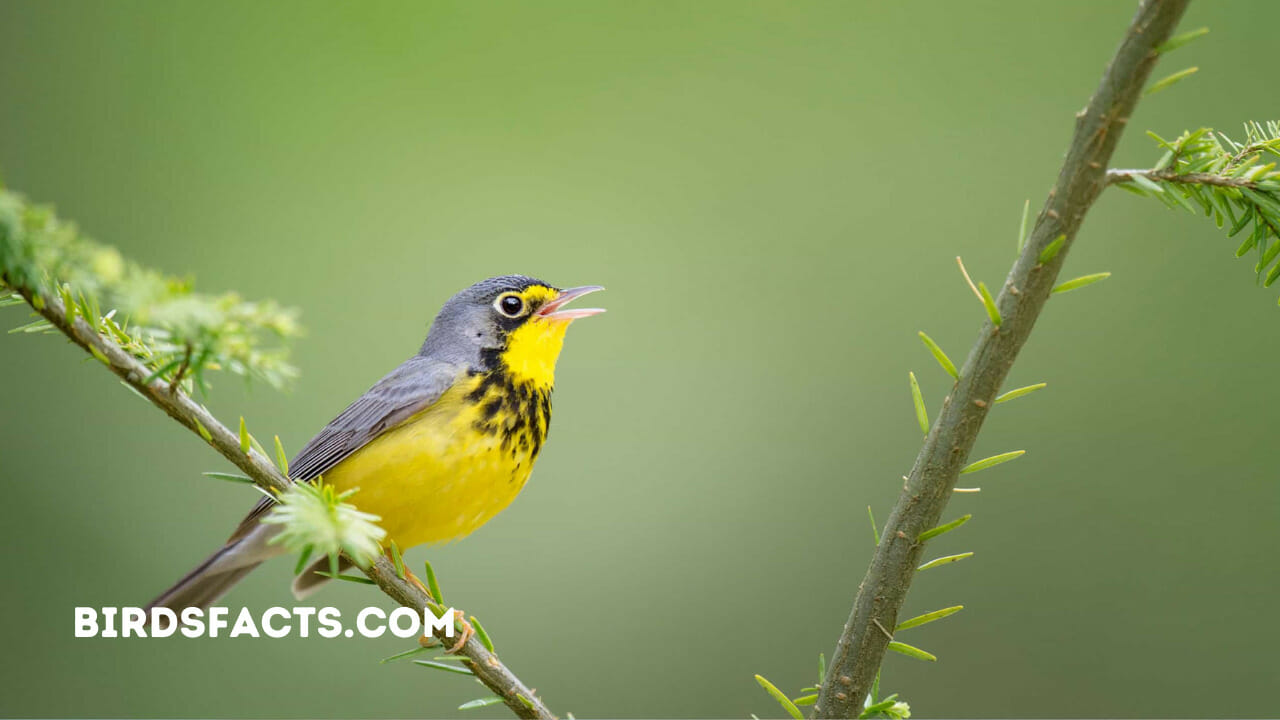
Canada Warbler Bird
Canada Warbler Facts
- Prey
- Insects
- Fun Fact
- These birds travel more than 3,000 miles during migration!
- Estimated Population Size
- 2,600,000
- Biggest Threat
- Habitat loss
- Most Distinctive Feature
- Its “necklace” of black feathers
- Distinctive Feature
- The white ring around each eye makes this bird look like it’s wearing glasses.
- Other Name(s)
- Necklaced Warbler
- Wingspan
- 7 – 9 inches
- Incubation Period
- 8-12 days
- Diet
- Omnivore
- Favorite Food
- Beetles, moths, flies, and caterpillars
- Type
- Bird
- Common Name
- Canada Warbler
- Number Of Species
- 5
- Nesting Location
- On or near the ground near a dense shrub
- Color
- Grey
- Yellow
- White
- Lifespan
- Up to 7 years
- Weight
- .32 – .46 ounces
- Height
- 3 – 4 inches
- Length
- 4.7 – 5.9 inches
Orange-crowned Warbler
The Orange-crowned Warbler, scientifically known as Leiothlypis celata, is a small passerine bird belonging to the New World warblers family. This bird species has a length range of 4.3-5.5 inches (11-14 cm) and weighs between 0.3-0.4 oz (7-11 g). Additionally, an Orange-crowned Warbler has a wingspan of approximately 7.5 inches (19 cm). One noteworthy aspect of this bird species is its greenish-yellow coloring, distinguishing it from other warbler species. The male and female Orange-crowned Warblers have similar physical characteristics, but the male’s crown color is typically brighter than the female’s. These birds are typically found in wooded environments with coniferous trees, such as pine and spruce trees. Orange-crowned Warblers build their nests in dense shrubs or on the ground when breeding. Overall, the orange-crowned Warbler is a fascinating species beloved by birdwatchers and conservationists.
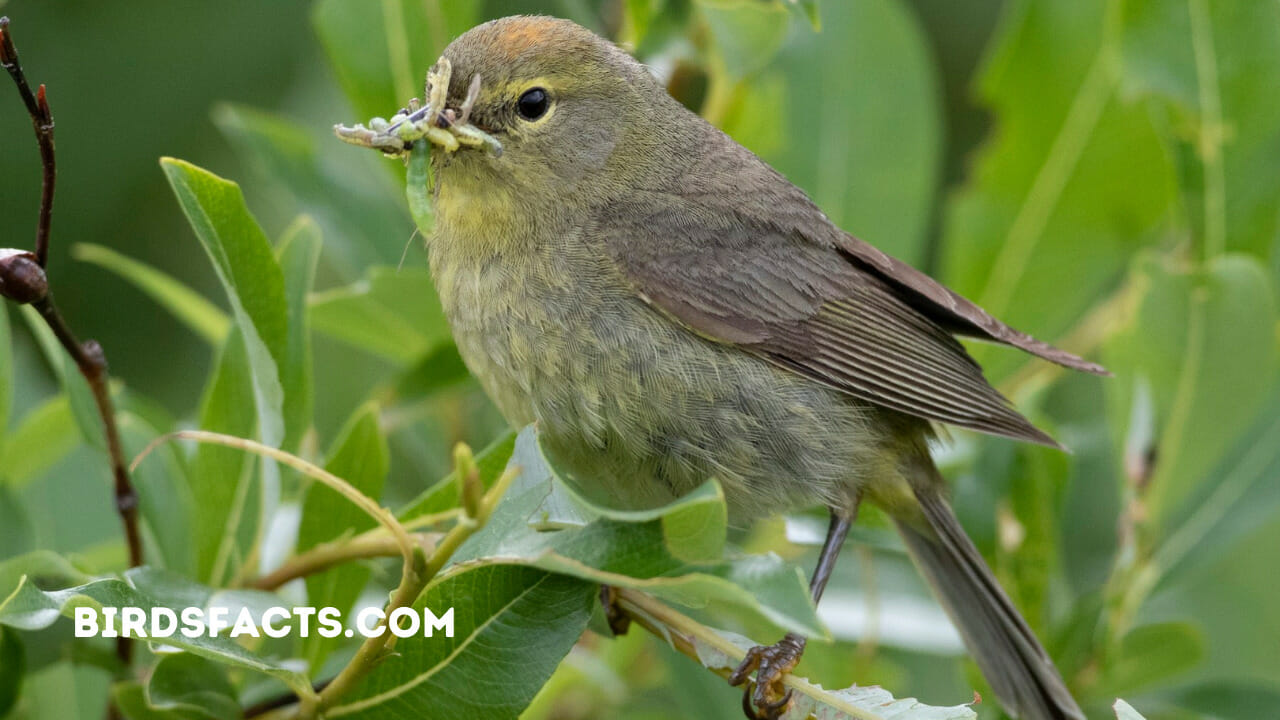
Orange-crowned Warbler Birds
Orange-Crowned Warbler Facts
- Prey
- Insects
- Fun Fact
- Often mistaken for the Tennessee Warblers, which are equally dull.
- Estimated Population Size
- 76 million
- Biggest Threat
- Global warming and urbanization.
- Most Distinctive Feature
- Yellow or dusky undertail.
- Wingspan
- 7.25 inches
- Incubation Period
- 12 days
- Litter Size
- 3-6 chicks
- Habitat
- Forests
- Predators
- Cats (domestic and wild), birds of prey (hawks, eagles, etc.)
- Diet
- Omnivore
- Type
- Bird
- Common Name
- Orange-crowned Warbler
- Number Of Species
- 1
- Location
- United States, Bahamas, Belize, Canada, Costa Rica, El Salvador, Guatemala, Mexico, Saint Pierre and Miquelon, and Turks and Caicos Islands.
- Nesting Location
- Ground, scrub oak, riverside willows.
- Migratory
- 1
- Color
- Yellow
- Black
- Olive
- Skin Type
- Feathers
- Top Speed
- 25 mph
- Lifespan
- 6 – 8 years
- Weight
- 9 grams
- Length
- 4.8 – 5.3 inches
Hooded Warbler
- Setophaga citrina
- Length: 5.1 in (13 cm)
- Weight: 0.3-0.4 oz (9-12 g)
- Wingspan: 6.9 in (17.5 cm)
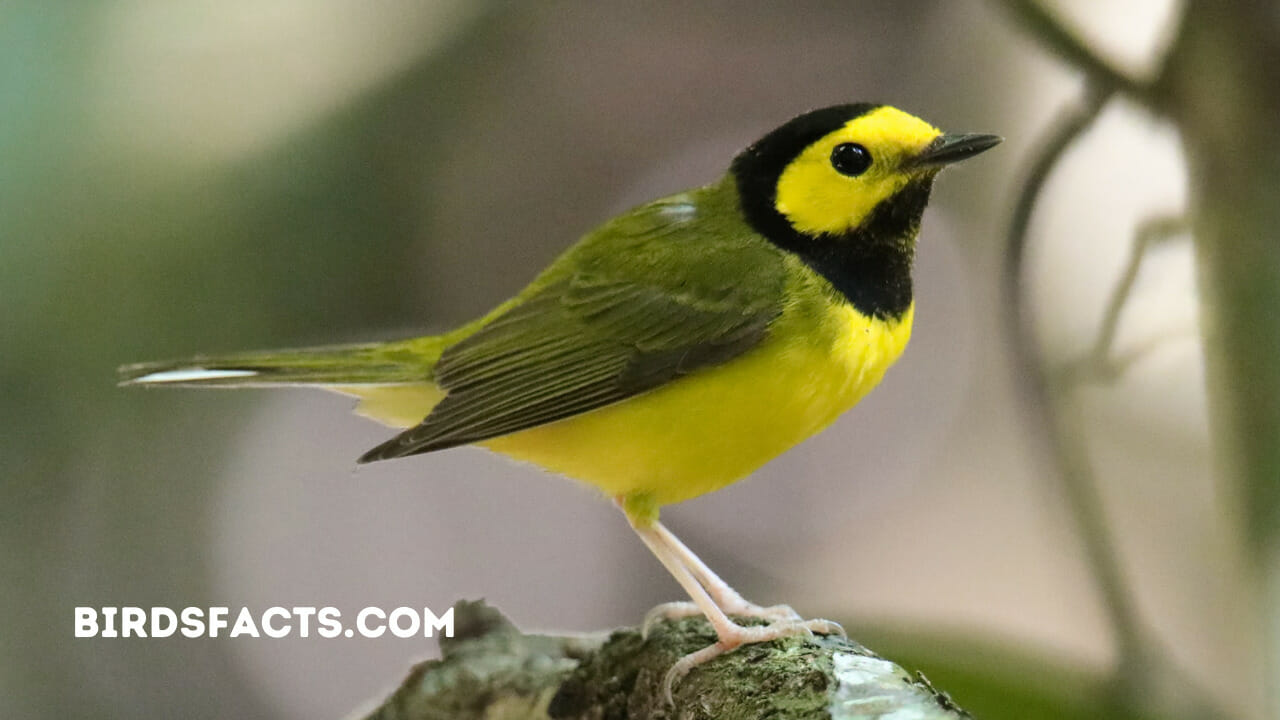
Hooded Warbler Birds
The Hooded Warbler, scientifically known as Setophaga citrina, is a small songbird that measures 5.1 inches (13 cm) in length and has a wingspan of 6.9 inches (17.5 cm). They weigh between 0.3-0.4 oz (9-12 g). The male Hooded Warbler has a distinguishing black hood covering its head and upper breast, while the rest of its feathers are vibrant yellow. Females, on the other hand, have duller heads and greenish-yellow bodies. These warblers prefer living in deciduous and mixed forests where they forage for insects and spiders. Hooded Warblers have a unique way of catching insects; they hover mid-air and snatch them in flight. These birds are found in the eastern United States during the breeding season and tend to migrate to Central America and northern South America during winter. Overall, the Hooded Warbler is a beautiful and fascinating bird that plays an important role in maintaining the biodiversity of forests.
Dickcissel
The Dickcissel, scientifically known as Spiza americana, is a small, striking bird with remarkably unique features. Measuring between 5.5-6.3 inches (14-16 centimeters) in length, it is neither too large nor too small, making it a perfect fit for various environmental settings. Its weight ranges between 0.9-1.4 ounces (25.6-38.4 grams), making it impressive enough to leave a lasting impact on wildlife enthusiasts while staying light and easy to carry during flight. The wingspan of this fascinating bird measures about 9.8-10.2 inches (24.8-26 centimeters), with beautifully patterned feathers that leave a lasting impression during its flight. As a member of the Spiza americana family, the Dickcissel is an exquisite species, displaying a perfect balance between elegance and adaptability. At the same time, its captivating physical attributes continue to be a subject of interest for ornithologists and bird lovers alike. Overall, the Dickcissel is a remarkable specimen showcasing the wonders of the natural world, drawing attention and admiration from all fortunate enough to encounter it.

dicksissle
Dickcissel Facts
- Prey
- Insects, Arachnids
- Group Behavior
- Flock
- Breeding pair
- Fun Fact
- They have a unique call that they are named for.
- Estimated Population Size
- 28 million
- Biggest Threat
- Loss of habitat, illegal hunting
- Most Distinctive Feature
- Yellow eye wing
- Wingspan
- 9.8 to 10.2 inches
- Incubation Period
- 12 to 13 days
- Age Of Independence
- 10 days
- Diet
- Omnivore
- Migratory
- 1
- Color
- Brown
- Grey
- Yellow
- Black
- White
- Skin Type
- Feathers
- Weight
- 0.9 to 1.4 ounces
- Length
- 5.5 and 6.3 inches
- Venomous
- No
Prothonotary Warbler
- Protonotaria citrea
- Length: 5.1 in (13 cm)
- Weight: 0.44 oz (12.5 g)
- Wingspan: 8.75 in (22 cm)

Prothonotary Warbler
The Prothonotary Warbler, or Protonotaria citrea, is a captivating and strikingly bright yellow songbird species with an esteemed place in the avian world. This small yet striking bird measures an impressive 5.1 inches (13 cm) in length and boasts an impressive wingspan of 8.75 inches (22 cm). Though it might appear delicate in size, this lively creature weighs a full 0.44 ounces (12.5 grams). The Prothonotary Warbler is predominantly characterized by its brilliant golden-yellow head, which effortlessly captures the attention of birdwatchers and nature enthusiasts alike. The vibrant plumage is accompanied by beautiful blue-grey wings and tails, adding a harmonious touch to its overall appearance. Due to their distinctive features and charming characteristics, Protonotaria citrea has garnered great affection from those fortunate enough to encounter this remarkable species in the wild. Their captivating presence serves as a reminder of nature’s undying and diverse beauty, ever-enthralling and endlessly fascinating.
Yellow-headed Blackbird
- Xanthocephalus xanthocephalus
- Length: 8.3-10.2 in (21-26 cm)
- Weight: 1.6-3.5 oz (44-100 g)
- Wingspan: 16.5-17.3 in (42-44 cm)

Yellow-headed Blackbird
The Yellow-headed Blackbird, scientifically known as Xanthocephalus xanthocephalus, is a strikingly distinctive North American songbird with a unique appearance. Males of this species exhibit brilliant yellow heads and chests, contrasting sharply with their jet-black bodies and wings. Females, on the other hand, display more subdued colors, making them less conspicuous. The Yellow-headed Blackbird boasts an impressive size, with a typical length ranging from 8.3 to 10.2 inches (21-26 cm) and a weight between 1.6 and 3.5 ounces (44-100 g). These numbers reflect their robust, stocky bodies and long, strong legs. Equally outstanding is their wingspan, which extends from 16.5 to 17.3 inches (42-44 cm) across. Given their vibrant plumage and striking features, the Yellow-headed Blackbird is an unmistakable presence in the wetlands and marshes it calls home, providing birdwatchers with a truly unforgettable sight.
Conclusion:
In conclusion, Yellow Birds in Michigan offers a captivating and vibrant spectacle for nature enthusiasts and birdwatchers. With their bright plumage and melodic songs, these avian wonders add a splash of color and charm to the diverse ecosystem of Michigan. Whether you’re an avid birdwatcher or simply someone looking to connect with nature, exploring the world of Yellow Birds in Michigan is an experience you will want to experience.
What Birds Are All Yellow?
There are no specific bird species that are entirely yellow. While some birds might have yellow feathers, it is mostly only on certain body parts. However, some bird species have a predominantly yellow coloration, such as the American goldfinch and the yellow Warbler, known for their bright yellow plumage. Other bird species might have more muted shades of yellow, or yellow might only appear as an accent color on their feathers. Ultimately, saying that a bird is entirely yellow is simply inaccurate.
What Are The Most Common Birds In Michigan?
The most common birds in Michigan are the American Robin, Black-capped Chickadee, Song Sparrow, Red-winged Blackbird, Blue Jay, American Goldfinch, and House Sparrow. These birds can be found everywhere, from the cities to the countryside, and they are often seen in parks, gardens, and even near residential areas.
What Birds Are Native To Michigan?
The most common birds in Michigan include the American Robin, Black-capped Chickadee, Mourning Dove, American Goldfinch, and Northern Cardinal. These birds can be found throughout the state in various habitats, from forests and wetlands to urban areas. Many of them are known for their beautiful songs and colorful plumage, making them a joy to see and hear.
What Bird Has A Yellow Chest?
Several bird species have a yellow chest, including American Goldfinches, Yellow Warblers, and Western Tanagers. The brightness and shade of yellow may vary amongst these birds, but their yellow chest is a distinguishing characteristic. The yellow coloration helps them attract mates and can also serve as a means of communication between individuals of the same species.
What Bird Has A Yellow Head?
“What bird has a yellow head?” is a common question among enthusiasts. One bird that fits the description is the Yellow Warbler. This small songbird is known for its bright yellow feathers, with the male sporting a bright yellow head and chest. The Yellow Warbler can be found throughout North and Central America during the breeding season.
Yellow Birds In Michigan?
Yellow birds in Michigan are a common sight, with several species in the state. The American goldfinch is perhaps the most recognizable, with its bright yellow plumage and distinctive black and white wings. Other yellow birds in Michigan include the yellow Warbler, yellow-throated vireo, and eastern meadowlark. These birds are welcome in the spring and summer months and can often be seen flitting about in gardens and fields.
Further Reading
You may also check out:
Thank you for reading!




